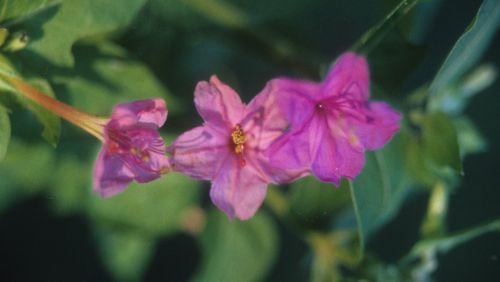Q: How do I eradicate four o’clock plants? The previous owner of my house planted them everywhere.Marshall Jones, email
A: This is another plant, like clerodendrum and sweet autumn clematis, that has attractive flowers but can be a garden thug. Mature four o'clock plants have a fleshy potato-like root that helps them recover from herbicide sprays. Digging them up is a good technique if you have a small area. If you decide to go the chemical route, a product that contains glyphosate plus triclopyr will work pretty fast but likely won't give complete control. Keep an eye out for small sprouts next spring and dig them up when spotted.
Q: I have a lot of old pines and dogwoods on my property. English ivy, trumpet vine and poison ivy are trying to take over everywhere. I would like to spray Roundup and kill everything but I'm concerned about getting it on the tree roots.Joel Jackson, Stone Mountain
A: The label on glyphosate products, like Roundup, directs users to avoid spraying on trunks and roots. In my observation, trees with thin bark, like American beech or crape myrtle, are more likely to be hurt by the weed killer than trees with thick bark, like pine. If you are conscientious about spraying glyphosate only on the leaves of the underbrush you're trying to control, I believe you can use it effectively without hurting the trees.
Q: I was happy to see a few beautiful red blooms come on our crape myrtle but it seems tall and thin. How can I get it to be thicker with more blooms?Lisa Way, Tucker
A: Crape myrtle flowers are produced on the ends of vigorous new growth. To accomplish more of that on your particular plant, I would try doing light pruning of the branches in January or February. You can remove limbs that are smaller than a finger but don't perform wholesale "crape murder" like less-enlightened gardeners do. It would help to put mulch under the tree extending from the trunk out four feet in all directions. If there is a lawn nearby there's no need to fertilize. Your plant gets all it needs from the lawn.
Q: I have a young Lady Banks rose. It has multiple long runners but not a single bloom. What could be wrong, and should I prune the long runners?John Detwiler, email
A: Depending on its age, the rose may simply be getting its root system established in your planting spot. In any case, don't prune 'Lady Banks' rose now. All of the flower buds for next spring have been formed and you don't want to remove them. If it is young, prune lightly after blooming next year. Remove damaged limbs but not much else. In the future, when it is growing vigorously, you can prune more heavily to keep it in bounds.






